Operational Predictors on MNC Performance in Malaysian Healthcare
VerifiedAdded on 2022/10/11
|13
|3094
|12
Report
AI Summary
This report investigates the operational predictors of multinational corporations (MNCs) in the Malaysian healthcare industry, with a specific focus on the moderating role of intercultural competence (ICC). The study begins with an introduction highlighting Malaysia's advancements in healthcare, including its universal healthcare access and the significance of the medical device sector. It examines the contributions of MNCs to the supply of medical devices and explores whether these organizations prioritize ICC in their operations. The report delves into the background, problem statement, research questions, and objectives, followed by a literature review covering intercultural competence and the technical contributions to the Malaysian healthcare sector. The research methodology section outlines the study design, research model, sampling method, data collection method, and ethical considerations. The conceptual framework is presented to illustrate the relationships between improved healthcare services, selling medical insurance, intercultural competence, and government initiatives. The research employs a qualitative research design, utilizing interviews with organizational members from five MNCs operating in Malaysia to gather data. The study aims to identify the technical and non-technical exposures of organizations in the healthcare sector, analyze the contribution of MNCs to the supply of medical devices, and investigate the incorporation of ICC. The findings are intended to provide insights into how MNCs can improve their operational performance by considering ICC in the context of Malaysia's diverse cultural landscape.
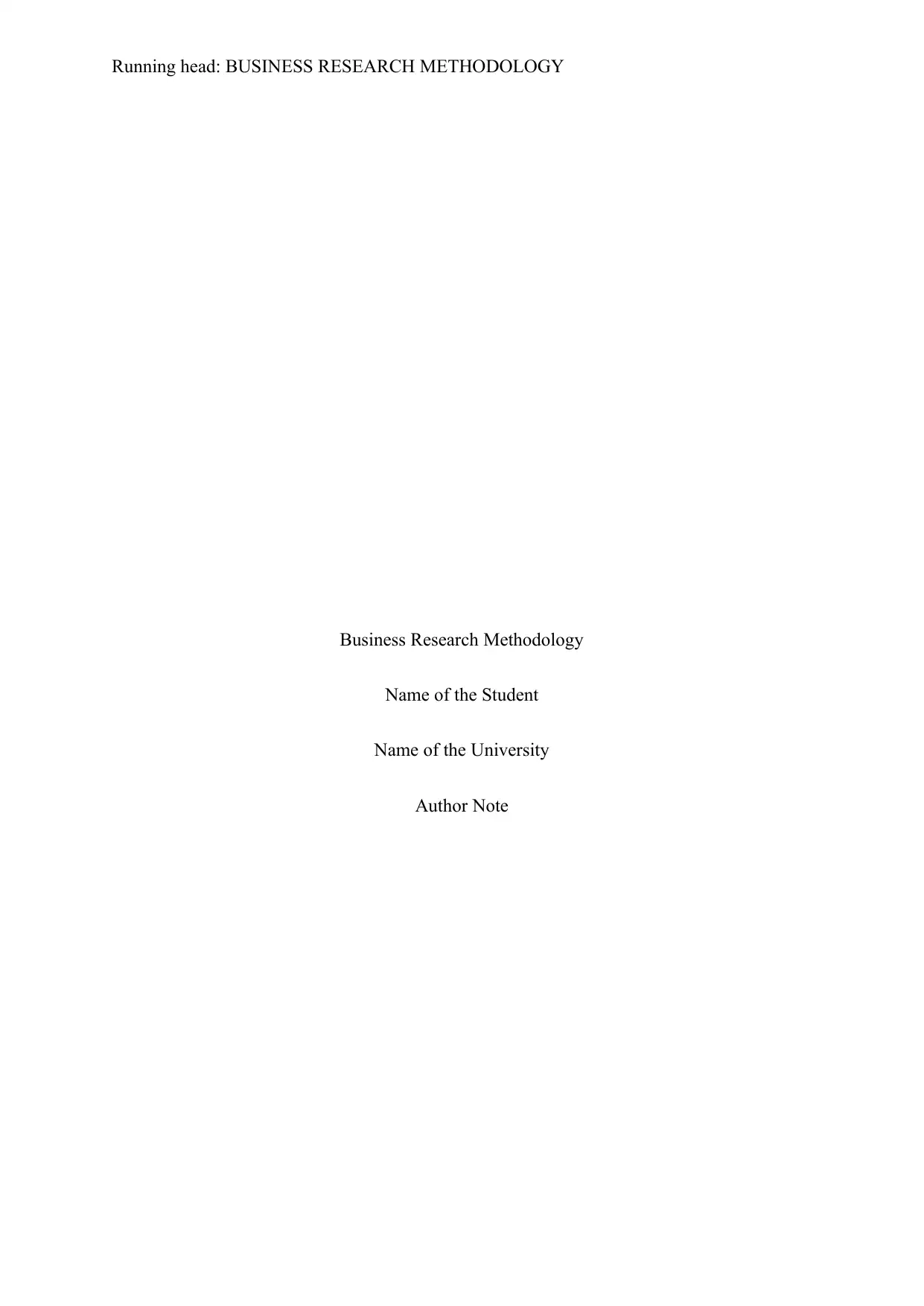
Running head: BUSINESS RESEARCH METHODOLOGY
Business Research Methodology
Name of the Student
Name of the University
Author Note
Business Research Methodology
Name of the Student
Name of the University
Author Note
Paraphrase This Document
Need a fresh take? Get an instant paraphrase of this document with our AI Paraphraser
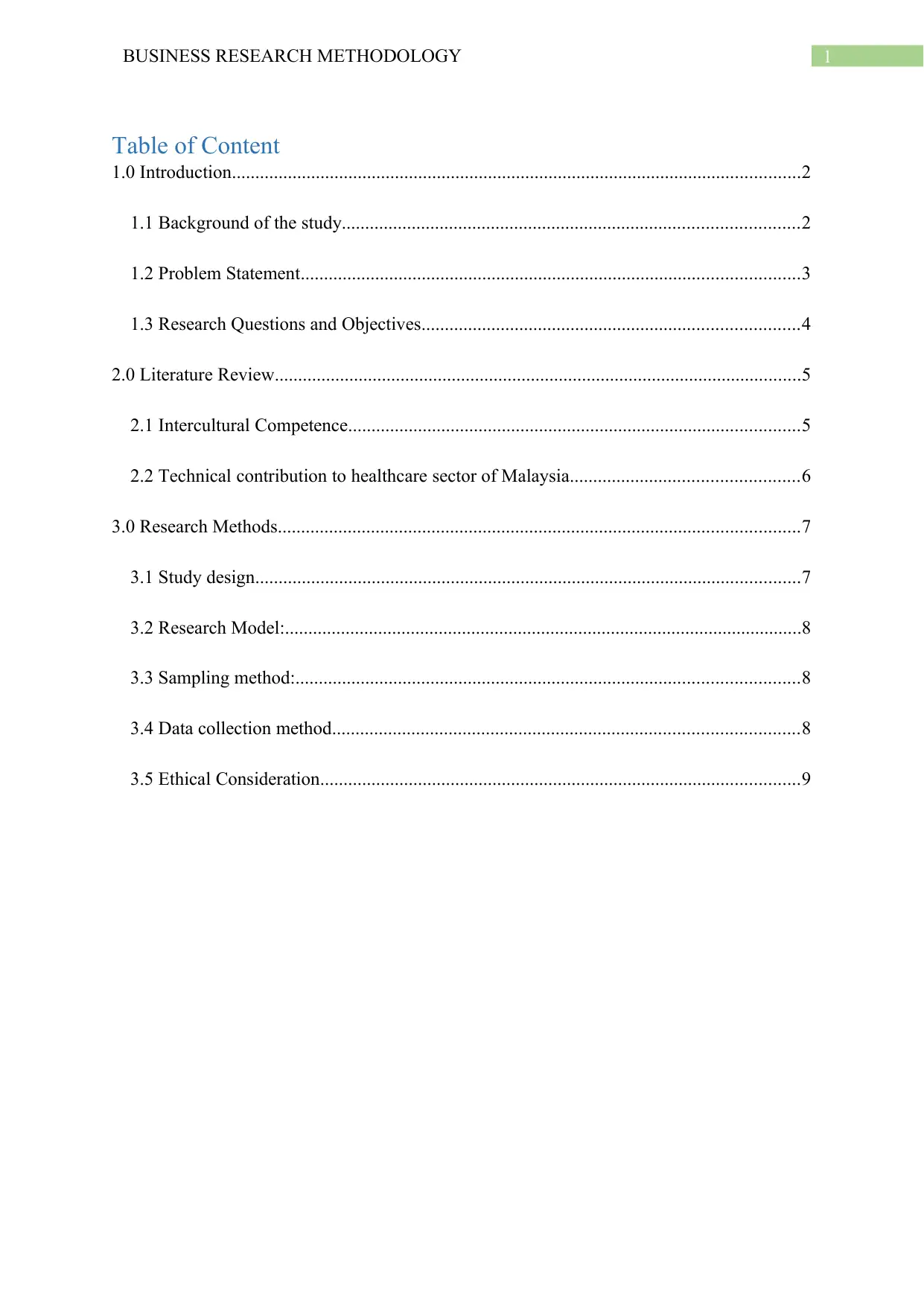
1BUSINESS RESEARCH METHODOLOGY
Table of Content
1.0 Introduction..........................................................................................................................2
1.1 Background of the study..................................................................................................2
1.2 Problem Statement...........................................................................................................3
1.3 Research Questions and Objectives.................................................................................4
2.0 Literature Review.................................................................................................................5
2.1 Intercultural Competence.................................................................................................5
2.2 Technical contribution to healthcare sector of Malaysia.................................................6
3.0 Research Methods................................................................................................................7
3.1 Study design.....................................................................................................................7
3.2 Research Model:...............................................................................................................8
3.3 Sampling method:............................................................................................................8
3.4 Data collection method....................................................................................................8
3.5 Ethical Consideration.......................................................................................................9
Table of Content
1.0 Introduction..........................................................................................................................2
1.1 Background of the study..................................................................................................2
1.2 Problem Statement...........................................................................................................3
1.3 Research Questions and Objectives.................................................................................4
2.0 Literature Review.................................................................................................................5
2.1 Intercultural Competence.................................................................................................5
2.2 Technical contribution to healthcare sector of Malaysia.................................................6
3.0 Research Methods................................................................................................................7
3.1 Study design.....................................................................................................................7
3.2 Research Model:...............................................................................................................8
3.3 Sampling method:............................................................................................................8
3.4 Data collection method....................................................................................................8
3.5 Ethical Consideration.......................................................................................................9
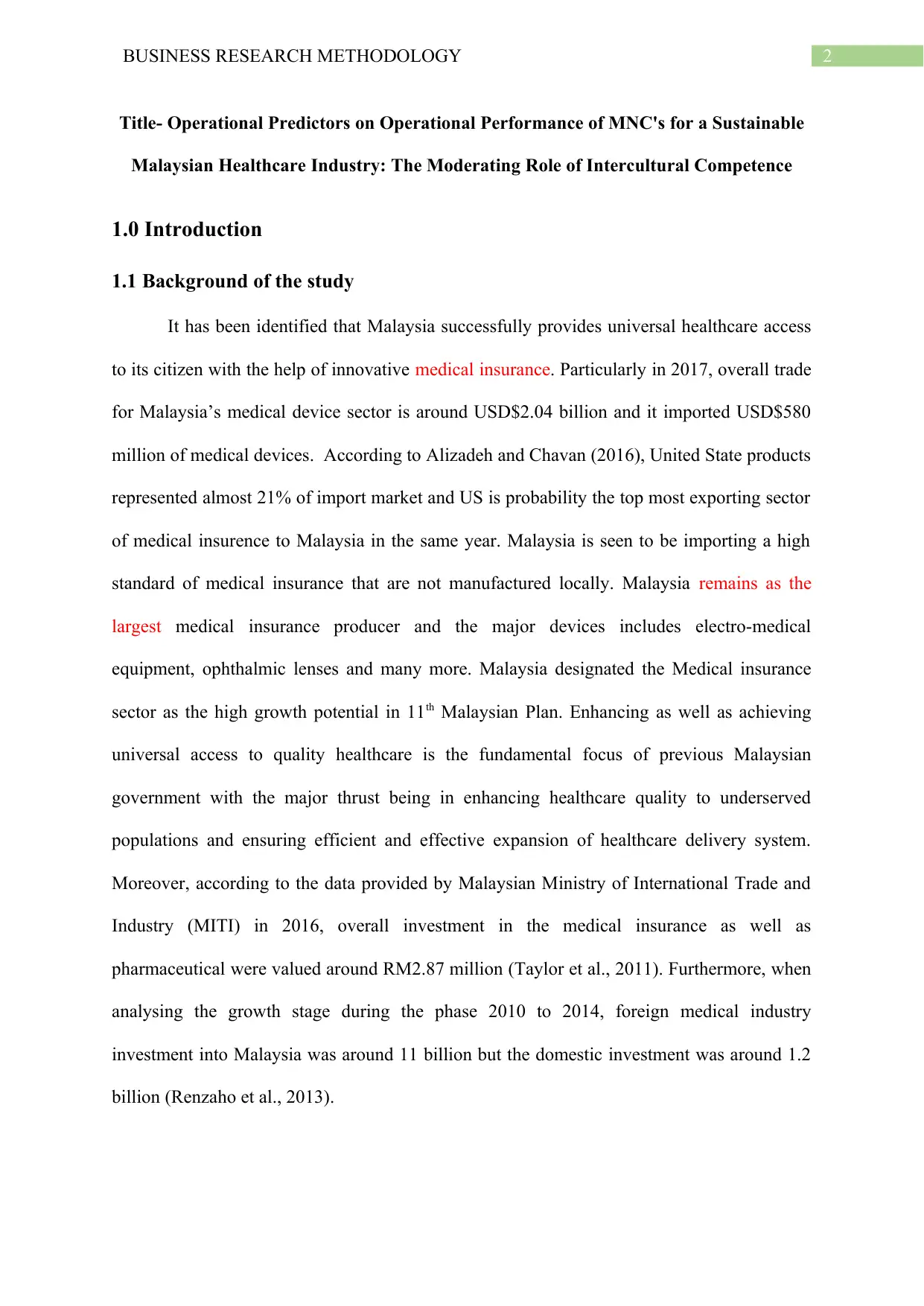
2BUSINESS RESEARCH METHODOLOGY
Title- Operational Predictors on Operational Performance of MNC's for a Sustainable
Malaysian Healthcare Industry: The Moderating Role of Intercultural Competence
1.0 Introduction
1.1 Background of the study
It has been identified that Malaysia successfully provides universal healthcare access
to its citizen with the help of innovative medical insurance. Particularly in 2017, overall trade
for Malaysia’s medical device sector is around USD$2.04 billion and it imported USD$580
million of medical devices. According to Alizadeh and Chavan (2016), United State products
represented almost 21% of import market and US is probability the top most exporting sector
of medical insurence to Malaysia in the same year. Malaysia is seen to be importing a high
standard of medical insurance that are not manufactured locally. Malaysia remains as the
largest medical insurance producer and the major devices includes electro-medical
equipment, ophthalmic lenses and many more. Malaysia designated the Medical insurance
sector as the high growth potential in 11th Malaysian Plan. Enhancing as well as achieving
universal access to quality healthcare is the fundamental focus of previous Malaysian
government with the major thrust being in enhancing healthcare quality to underserved
populations and ensuring efficient and effective expansion of healthcare delivery system.
Moreover, according to the data provided by Malaysian Ministry of International Trade and
Industry (MITI) in 2016, overall investment in the medical insurance as well as
pharmaceutical were valued around RM2.87 million (Taylor et al., 2011). Furthermore, when
analysing the growth stage during the phase 2010 to 2014, foreign medical industry
investment into Malaysia was around 11 billion but the domestic investment was around 1.2
billion (Renzaho et al., 2013).
Title- Operational Predictors on Operational Performance of MNC's for a Sustainable
Malaysian Healthcare Industry: The Moderating Role of Intercultural Competence
1.0 Introduction
1.1 Background of the study
It has been identified that Malaysia successfully provides universal healthcare access
to its citizen with the help of innovative medical insurance. Particularly in 2017, overall trade
for Malaysia’s medical device sector is around USD$2.04 billion and it imported USD$580
million of medical devices. According to Alizadeh and Chavan (2016), United State products
represented almost 21% of import market and US is probability the top most exporting sector
of medical insurence to Malaysia in the same year. Malaysia is seen to be importing a high
standard of medical insurance that are not manufactured locally. Malaysia remains as the
largest medical insurance producer and the major devices includes electro-medical
equipment, ophthalmic lenses and many more. Malaysia designated the Medical insurance
sector as the high growth potential in 11th Malaysian Plan. Enhancing as well as achieving
universal access to quality healthcare is the fundamental focus of previous Malaysian
government with the major thrust being in enhancing healthcare quality to underserved
populations and ensuring efficient and effective expansion of healthcare delivery system.
Moreover, according to the data provided by Malaysian Ministry of International Trade and
Industry (MITI) in 2016, overall investment in the medical insurance as well as
pharmaceutical were valued around RM2.87 million (Taylor et al., 2011). Furthermore, when
analysing the growth stage during the phase 2010 to 2014, foreign medical industry
investment into Malaysia was around 11 billion but the domestic investment was around 1.2
billion (Renzaho et al., 2013).
⊘ This is a preview!⊘
Do you want full access?
Subscribe today to unlock all pages.

Trusted by 1+ million students worldwide
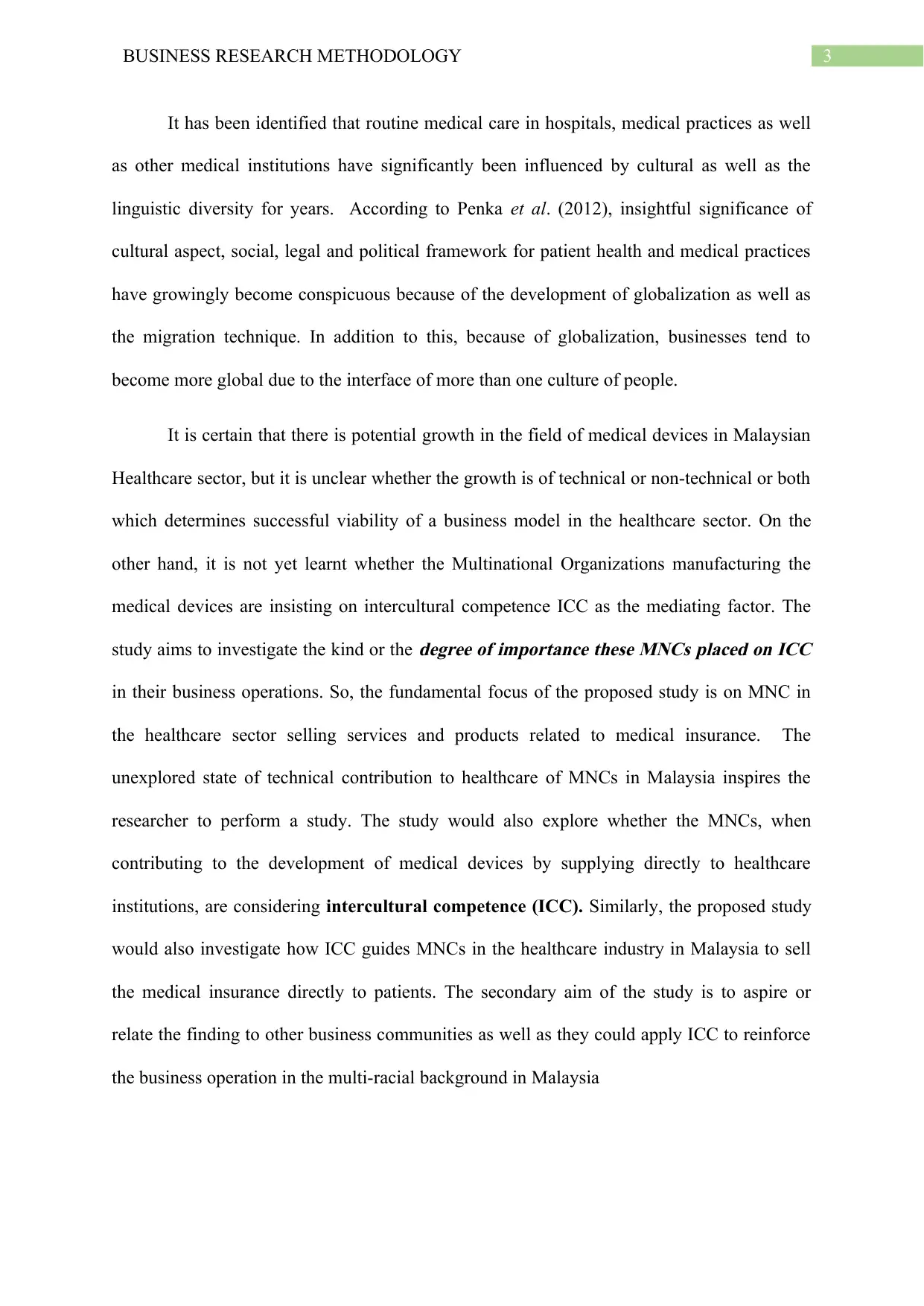
3BUSINESS RESEARCH METHODOLOGY
It has been identified that routine medical care in hospitals, medical practices as well
as other medical institutions have significantly been influenced by cultural as well as the
linguistic diversity for years. According to Penka et al. (2012), insightful significance of
cultural aspect, social, legal and political framework for patient health and medical practices
have growingly become conspicuous because of the development of globalization as well as
the migration technique. In addition to this, because of globalization, businesses tend to
become more global due to the interface of more than one culture of people.
It is certain that there is potential growth in the field of medical devices in Malaysian
Healthcare sector, but it is unclear whether the growth is of technical or non-technical or both
which determines successful viability of a business model in the healthcare sector. On the
other hand, it is not yet learnt whether the Multinational Organizations manufacturing the
medical devices are insisting on intercultural competence ICC as the mediating factor. The
study aims to investigate the kind or the
degree of importance these MNCs placed on ICC
in their business operations. So, the fundamental focus of the proposed study is on MNC in
the healthcare sector selling services and products related to medical insurance. The
unexplored state of technical contribution to healthcare of MNCs in Malaysia inspires the
researcher to perform a study. The study would also explore whether the MNCs, when
contributing to the development of medical devices by supplying directly to healthcare
institutions, are considering intercultural competence (ICC). Similarly, the proposed study
would also investigate how ICC guides MNCs in the healthcare industry in Malaysia to sell
the medical insurance directly to patients. The secondary aim of the study is to aspire or
relate the finding to other business communities as well as they could apply ICC to reinforce
the business operation in the multi-racial background in Malaysia
It has been identified that routine medical care in hospitals, medical practices as well
as other medical institutions have significantly been influenced by cultural as well as the
linguistic diversity for years. According to Penka et al. (2012), insightful significance of
cultural aspect, social, legal and political framework for patient health and medical practices
have growingly become conspicuous because of the development of globalization as well as
the migration technique. In addition to this, because of globalization, businesses tend to
become more global due to the interface of more than one culture of people.
It is certain that there is potential growth in the field of medical devices in Malaysian
Healthcare sector, but it is unclear whether the growth is of technical or non-technical or both
which determines successful viability of a business model in the healthcare sector. On the
other hand, it is not yet learnt whether the Multinational Organizations manufacturing the
medical devices are insisting on intercultural competence ICC as the mediating factor. The
study aims to investigate the kind or the
degree of importance these MNCs placed on ICC
in their business operations. So, the fundamental focus of the proposed study is on MNC in
the healthcare sector selling services and products related to medical insurance. The
unexplored state of technical contribution to healthcare of MNCs in Malaysia inspires the
researcher to perform a study. The study would also explore whether the MNCs, when
contributing to the development of medical devices by supplying directly to healthcare
institutions, are considering intercultural competence (ICC). Similarly, the proposed study
would also investigate how ICC guides MNCs in the healthcare industry in Malaysia to sell
the medical insurance directly to patients. The secondary aim of the study is to aspire or
relate the finding to other business communities as well as they could apply ICC to reinforce
the business operation in the multi-racial background in Malaysia
Paraphrase This Document
Need a fresh take? Get an instant paraphrase of this document with our AI Paraphraser
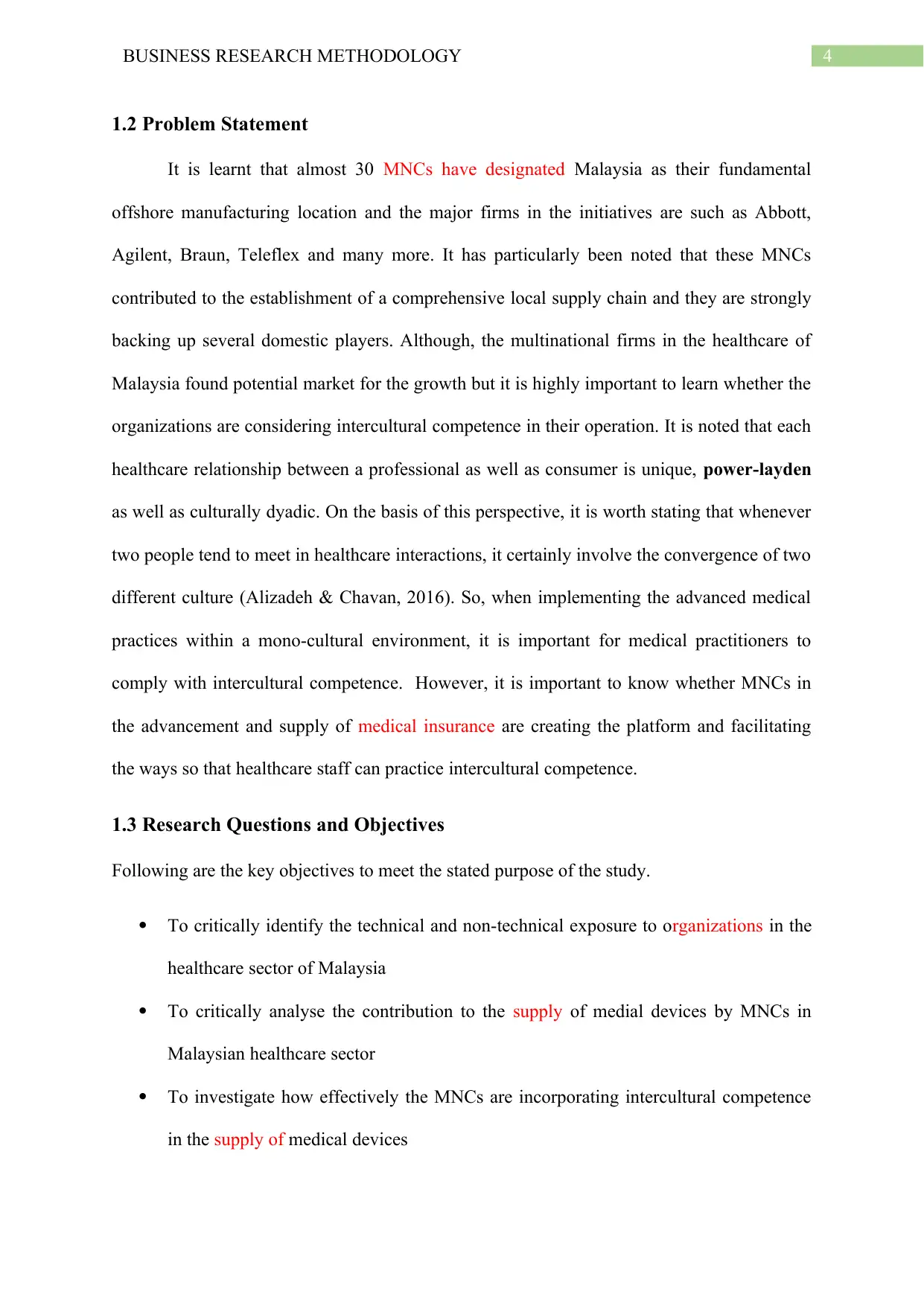
4BUSINESS RESEARCH METHODOLOGY
1.2 Problem Statement
It is learnt that almost 30 MNCs have designated Malaysia as their fundamental
offshore manufacturing location and the major firms in the initiatives are such as Abbott,
Agilent, Braun, Teleflex and many more. It has particularly been noted that these MNCs
contributed to the establishment of a comprehensive local supply chain and they are strongly
backing up several domestic players. Although, the multinational firms in the healthcare of
Malaysia found potential market for the growth but it is highly important to learn whether the
organizations are considering intercultural competence in their operation. It is noted that each
healthcare relationship between a professional as well as consumer is unique, power-layden
as well as culturally dyadic. On the basis of this perspective, it is worth stating that whenever
two people tend to meet in healthcare interactions, it certainly involve the convergence of two
different culture (Alizadeh & Chavan, 2016). So, when implementing the advanced medical
practices within a mono-cultural environment, it is important for medical practitioners to
comply with intercultural competence. However, it is important to know whether MNCs in
the advancement and supply of medical insurance are creating the platform and facilitating
the ways so that healthcare staff can practice intercultural competence.
1.3 Research Questions and Objectives
Following are the key objectives to meet the stated purpose of the study.
To critically identify the technical and non-technical exposure to organizations in the
healthcare sector of Malaysia
To critically analyse the contribution to the supply of medial devices by MNCs in
Malaysian healthcare sector
To investigate how effectively the MNCs are incorporating intercultural competence
in the supply of medical devices
1.2 Problem Statement
It is learnt that almost 30 MNCs have designated Malaysia as their fundamental
offshore manufacturing location and the major firms in the initiatives are such as Abbott,
Agilent, Braun, Teleflex and many more. It has particularly been noted that these MNCs
contributed to the establishment of a comprehensive local supply chain and they are strongly
backing up several domestic players. Although, the multinational firms in the healthcare of
Malaysia found potential market for the growth but it is highly important to learn whether the
organizations are considering intercultural competence in their operation. It is noted that each
healthcare relationship between a professional as well as consumer is unique, power-layden
as well as culturally dyadic. On the basis of this perspective, it is worth stating that whenever
two people tend to meet in healthcare interactions, it certainly involve the convergence of two
different culture (Alizadeh & Chavan, 2016). So, when implementing the advanced medical
practices within a mono-cultural environment, it is important for medical practitioners to
comply with intercultural competence. However, it is important to know whether MNCs in
the advancement and supply of medical insurance are creating the platform and facilitating
the ways so that healthcare staff can practice intercultural competence.
1.3 Research Questions and Objectives
Following are the key objectives to meet the stated purpose of the study.
To critically identify the technical and non-technical exposure to organizations in the
healthcare sector of Malaysia
To critically analyse the contribution to the supply of medial devices by MNCs in
Malaysian healthcare sector
To investigate how effectively the MNCs are incorporating intercultural competence
in the supply of medical devices

5BUSINESS RESEARCH METHODOLOGY
Research Questions
How are MNCs in Malaysia applying the norms of ICC in selling of medical
devices?
How do the MNCs back the healthcare sector of Malaysia through the
development of technology
2.0 Literature Review
It has been identified that a major challenge for today’s healthcare service providers
across the world is that culturally diverse groups could compromise the largest growing
segment of patient population. It is noted that individual healthcare choices as well as the
outcome could be understandable to patients with respect to their own culture and experience.
Consequently, healthcare providers faced the need of developing intercultural competencies
could allow them to identify their own cultural norms, understand patients’ unique viewpoint
as well as effectively adjust their behaviour to enhance care. While understanding clients’
unique perspective is a significant barrier shared across sectors, in healthcare, intercultural
competence is most likely to be argued to be more complicated and challenging.
2.1 Intercultural Competence
Intercultural Competence is also known as cross cultural competence. The definition
gives a three factor model such as the ability to deal with psychological stress, ability to
interact effective and ability to develop the interpersonal relationship. As put forward by
Alizadeh and Chavan (2016) intercultural competence could involve three related dimension
such as sensitivity, awareness and skills and here, sensitivity fundamentally refers to an
individual capacity to understand as well as appreciate the cultural differences. Aigbogun,
Ghazali and Razali (2014) insisted on the fact that intercultural competence is highly
significant of any healthcare providers’ general competence. It has also been studied that
Research Questions
How are MNCs in Malaysia applying the norms of ICC in selling of medical
devices?
How do the MNCs back the healthcare sector of Malaysia through the
development of technology
2.0 Literature Review
It has been identified that a major challenge for today’s healthcare service providers
across the world is that culturally diverse groups could compromise the largest growing
segment of patient population. It is noted that individual healthcare choices as well as the
outcome could be understandable to patients with respect to their own culture and experience.
Consequently, healthcare providers faced the need of developing intercultural competencies
could allow them to identify their own cultural norms, understand patients’ unique viewpoint
as well as effectively adjust their behaviour to enhance care. While understanding clients’
unique perspective is a significant barrier shared across sectors, in healthcare, intercultural
competence is most likely to be argued to be more complicated and challenging.
2.1 Intercultural Competence
Intercultural Competence is also known as cross cultural competence. The definition
gives a three factor model such as the ability to deal with psychological stress, ability to
interact effective and ability to develop the interpersonal relationship. As put forward by
Alizadeh and Chavan (2016) intercultural competence could involve three related dimension
such as sensitivity, awareness and skills and here, sensitivity fundamentally refers to an
individual capacity to understand as well as appreciate the cultural differences. Aigbogun,
Ghazali and Razali (2014) insisted on the fact that intercultural competence is highly
significant of any healthcare providers’ general competence. It has also been studied that
⊘ This is a preview!⊘
Do you want full access?
Subscribe today to unlock all pages.

Trusted by 1+ million students worldwide
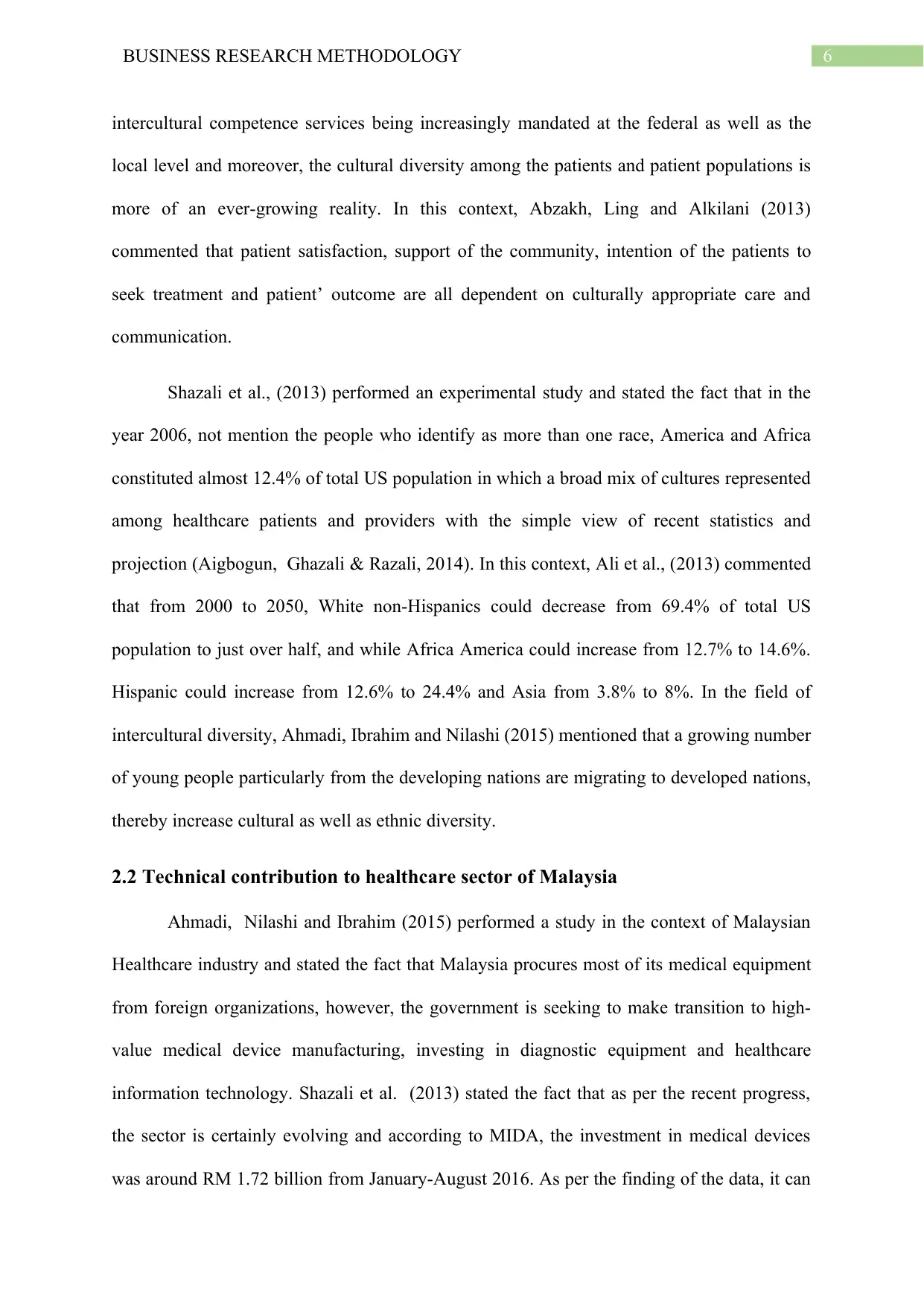
6BUSINESS RESEARCH METHODOLOGY
intercultural competence services being increasingly mandated at the federal as well as the
local level and moreover, the cultural diversity among the patients and patient populations is
more of an ever-growing reality. In this context, Abzakh, Ling and Alkilani (2013)
commented that patient satisfaction, support of the community, intention of the patients to
seek treatment and patient’ outcome are all dependent on culturally appropriate care and
communication.
Shazali et al., (2013) performed an experimental study and stated the fact that in the
year 2006, not mention the people who identify as more than one race, America and Africa
constituted almost 12.4% of total US population in which a broad mix of cultures represented
among healthcare patients and providers with the simple view of recent statistics and
projection (Aigbogun, Ghazali & Razali, 2014). In this context, Ali et al., (2013) commented
that from 2000 to 2050, White non-Hispanics could decrease from 69.4% of total US
population to just over half, and while Africa America could increase from 12.7% to 14.6%.
Hispanic could increase from 12.6% to 24.4% and Asia from 3.8% to 8%. In the field of
intercultural diversity, Ahmadi, Ibrahim and Nilashi (2015) mentioned that a growing number
of young people particularly from the developing nations are migrating to developed nations,
thereby increase cultural as well as ethnic diversity.
2.2 Technical contribution to healthcare sector of Malaysia
Ahmadi, Nilashi and Ibrahim (2015) performed a study in the context of Malaysian
Healthcare industry and stated the fact that Malaysia procures most of its medical equipment
from foreign organizations, however, the government is seeking to make transition to high-
value medical device manufacturing, investing in diagnostic equipment and healthcare
information technology. Shazali et al. (2013) stated the fact that as per the recent progress,
the sector is certainly evolving and according to MIDA, the investment in medical devices
was around RM 1.72 billion from January-August 2016. As per the finding of the data, it can
intercultural competence services being increasingly mandated at the federal as well as the
local level and moreover, the cultural diversity among the patients and patient populations is
more of an ever-growing reality. In this context, Abzakh, Ling and Alkilani (2013)
commented that patient satisfaction, support of the community, intention of the patients to
seek treatment and patient’ outcome are all dependent on culturally appropriate care and
communication.
Shazali et al., (2013) performed an experimental study and stated the fact that in the
year 2006, not mention the people who identify as more than one race, America and Africa
constituted almost 12.4% of total US population in which a broad mix of cultures represented
among healthcare patients and providers with the simple view of recent statistics and
projection (Aigbogun, Ghazali & Razali, 2014). In this context, Ali et al., (2013) commented
that from 2000 to 2050, White non-Hispanics could decrease from 69.4% of total US
population to just over half, and while Africa America could increase from 12.7% to 14.6%.
Hispanic could increase from 12.6% to 24.4% and Asia from 3.8% to 8%. In the field of
intercultural diversity, Ahmadi, Ibrahim and Nilashi (2015) mentioned that a growing number
of young people particularly from the developing nations are migrating to developed nations,
thereby increase cultural as well as ethnic diversity.
2.2 Technical contribution to healthcare sector of Malaysia
Ahmadi, Nilashi and Ibrahim (2015) performed a study in the context of Malaysian
Healthcare industry and stated the fact that Malaysia procures most of its medical equipment
from foreign organizations, however, the government is seeking to make transition to high-
value medical device manufacturing, investing in diagnostic equipment and healthcare
information technology. Shazali et al. (2013) stated the fact that as per the recent progress,
the sector is certainly evolving and according to MIDA, the investment in medical devices
was around RM 1.72 billion from January-August 2016. As per the finding of the data, it can
Paraphrase This Document
Need a fresh take? Get an instant paraphrase of this document with our AI Paraphraser
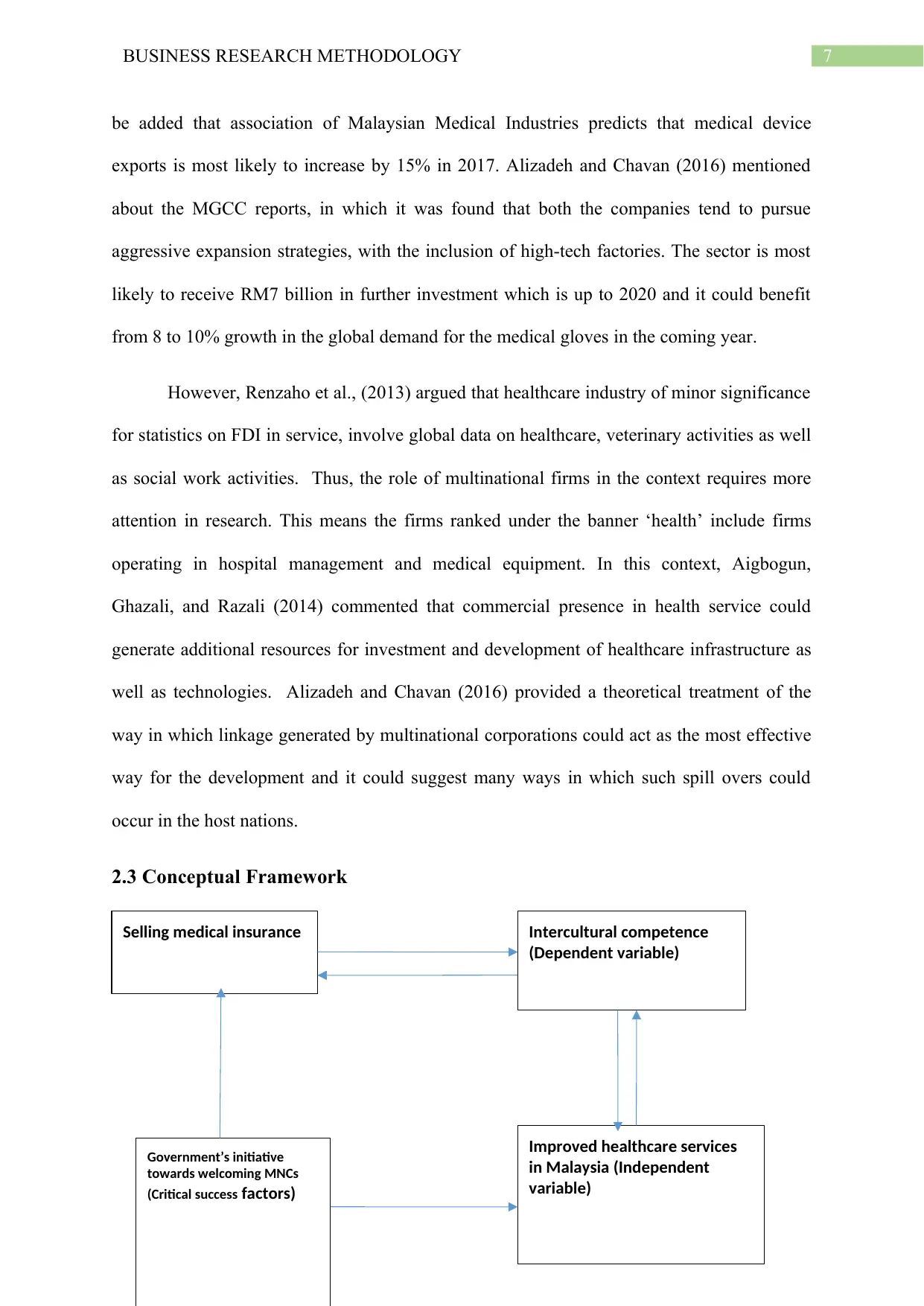
7BUSINESS RESEARCH METHODOLOGY
be added that association of Malaysian Medical Industries predicts that medical device
exports is most likely to increase by 15% in 2017. Alizadeh and Chavan (2016) mentioned
about the MGCC reports, in which it was found that both the companies tend to pursue
aggressive expansion strategies, with the inclusion of high-tech factories. The sector is most
likely to receive RM7 billion in further investment which is up to 2020 and it could benefit
from 8 to 10% growth in the global demand for the medical gloves in the coming year.
However, Renzaho et al., (2013) argued that healthcare industry of minor significance
for statistics on FDI in service, involve global data on healthcare, veterinary activities as well
as social work activities. Thus, the role of multinational firms in the context requires more
attention in research. This means the firms ranked under the banner ‘health’ include firms
operating in hospital management and medical equipment. In this context, Aigbogun,
Ghazali, and Razali (2014) commented that commercial presence in health service could
generate additional resources for investment and development of healthcare infrastructure as
well as technologies. Alizadeh and Chavan (2016) provided a theoretical treatment of the
way in which linkage generated by multinational corporations could act as the most effective
way for the development and it could suggest many ways in which such spill overs could
occur in the host nations.
2.3 Conceptual Framework
Improved healthcare services
in Malaysia (Independent
variable)
Selling medical insurance Intercultural competence
(Dependent variable)
Government’s initiative
towards welcoming MNCs
(Critical success factors)
be added that association of Malaysian Medical Industries predicts that medical device
exports is most likely to increase by 15% in 2017. Alizadeh and Chavan (2016) mentioned
about the MGCC reports, in which it was found that both the companies tend to pursue
aggressive expansion strategies, with the inclusion of high-tech factories. The sector is most
likely to receive RM7 billion in further investment which is up to 2020 and it could benefit
from 8 to 10% growth in the global demand for the medical gloves in the coming year.
However, Renzaho et al., (2013) argued that healthcare industry of minor significance
for statistics on FDI in service, involve global data on healthcare, veterinary activities as well
as social work activities. Thus, the role of multinational firms in the context requires more
attention in research. This means the firms ranked under the banner ‘health’ include firms
operating in hospital management and medical equipment. In this context, Aigbogun,
Ghazali, and Razali (2014) commented that commercial presence in health service could
generate additional resources for investment and development of healthcare infrastructure as
well as technologies. Alizadeh and Chavan (2016) provided a theoretical treatment of the
way in which linkage generated by multinational corporations could act as the most effective
way for the development and it could suggest many ways in which such spill overs could
occur in the host nations.
2.3 Conceptual Framework
Improved healthcare services
in Malaysia (Independent
variable)
Selling medical insurance Intercultural competence
(Dependent variable)
Government’s initiative
towards welcoming MNCs
(Critical success factors)

8BUSINESS RESEARCH METHODOLOGY
Figure 1: Conceptual Framework
3.0 Research Methods
3.1 Study design
In order to investigate and gain an insight about how MNCs in the healthcare sector of
Malaysia contributes to the sales of medical devices and incorporates intercultural
competence when selling medical services, it is always effective to choose and apply the
primary research method (Scheurich, 2014). Thus, to apply the primary research methods,
qualitative research design will be applied.
In order to collect quantitative data, an interview method will be applied in which
organizational members of 5 different Multinational Organizations currently operating in
Malaysia would be engaged in interview method.
3.2 Research Model:
As the proposed study would include qualitative research design model, it is effective
to use systematic subjective approach which would be used to explain real-world facts and
provide a suitable insight. The model is applied with a reflectivity attitude that helps to
construct knowledge at every step of the research process. With the help of reflectivity,
researcher can analyse the context of the study from different positions or the perspectives.
This could lead to the development of different, equally valid, understanding of a specific
situation under the study. In order to implement this process, reflexive journal diary would be
analysed where the scholar could make regular entries during the study technique.
Figure 1: Conceptual Framework
3.0 Research Methods
3.1 Study design
In order to investigate and gain an insight about how MNCs in the healthcare sector of
Malaysia contributes to the sales of medical devices and incorporates intercultural
competence when selling medical services, it is always effective to choose and apply the
primary research method (Scheurich, 2014). Thus, to apply the primary research methods,
qualitative research design will be applied.
In order to collect quantitative data, an interview method will be applied in which
organizational members of 5 different Multinational Organizations currently operating in
Malaysia would be engaged in interview method.
3.2 Research Model:
As the proposed study would include qualitative research design model, it is effective
to use systematic subjective approach which would be used to explain real-world facts and
provide a suitable insight. The model is applied with a reflectivity attitude that helps to
construct knowledge at every step of the research process. With the help of reflectivity,
researcher can analyse the context of the study from different positions or the perspectives.
This could lead to the development of different, equally valid, understanding of a specific
situation under the study. In order to implement this process, reflexive journal diary would be
analysed where the scholar could make regular entries during the study technique.
⊘ This is a preview!⊘
Do you want full access?
Subscribe today to unlock all pages.

Trusted by 1+ million students worldwide

9BUSINESS RESEARCH METHODOLOGY
3.3 Sampling method:
In order to perform the primary research to learn whether MNCs are applying
intercultural competence in selling the developed medical devices, organizational members
will be engaged in interview process. A non-probability sampling method would be used to
select the members because non-probability method helps to particularly choose members
that knowledge about the context of the study. On the other side, probability sampling
method will not be used in the study because probability method enables random selection
which is ineffective for the present study.
3.4 Data collection method
To collect the data, an interview method would be applied. So, to perform the
interview, an open-ended questionnaire will be developed. A semi –structure interview
method would be applied in which additional questions related to research context can be
asked.
Data Reliability and Validity
All data which would be collected for the analysis are validated because the data are
collected from real-word sources. On the other side, the data collected for the analysis are
reliable because similar outcome can be derived from the study if the same instruments are
used in the study.
3.5 Ethical Consideration
As the proposed study would include a primary data analysis method, it is highly
important to acknowledge the ethical grounds. When collecting the primary data, it would be
ensured that identity of the respondents have not been revealed. To maintain the
confidentiality of the data, Data Protection Act 2015 would be followed. Researcher would
ensure that no respondent is forced to take part in the data collection process.
3.3 Sampling method:
In order to perform the primary research to learn whether MNCs are applying
intercultural competence in selling the developed medical devices, organizational members
will be engaged in interview process. A non-probability sampling method would be used to
select the members because non-probability method helps to particularly choose members
that knowledge about the context of the study. On the other side, probability sampling
method will not be used in the study because probability method enables random selection
which is ineffective for the present study.
3.4 Data collection method
To collect the data, an interview method would be applied. So, to perform the
interview, an open-ended questionnaire will be developed. A semi –structure interview
method would be applied in which additional questions related to research context can be
asked.
Data Reliability and Validity
All data which would be collected for the analysis are validated because the data are
collected from real-word sources. On the other side, the data collected for the analysis are
reliable because similar outcome can be derived from the study if the same instruments are
used in the study.
3.5 Ethical Consideration
As the proposed study would include a primary data analysis method, it is highly
important to acknowledge the ethical grounds. When collecting the primary data, it would be
ensured that identity of the respondents have not been revealed. To maintain the
confidentiality of the data, Data Protection Act 2015 would be followed. Researcher would
ensure that no respondent is forced to take part in the data collection process.
Paraphrase This Document
Need a fresh take? Get an instant paraphrase of this document with our AI Paraphraser

10BUSINESS RESEARCH METHODOLOGY

11BUSINESS RESEARCH METHODOLOGY
References
Abzakh, A. A., Ling, K. C., & Alkilani, K. (2013). The impact of perceived risks on the
consumer resistance towards generic drugs in the malaysia pharmaceutical
industry. International Journal of Business and Management, 8(3), 42.
Ahmadi, H., Ibrahim, O., & Nilashi, M. (2015). Investigating a new framework for hospital
information system adoption: a case on Malaysia. Journal of Soft Computing and
Decision Support Systems, 2(2), 26-33.
Ahmadi, H., Nilashi, M., & Ibrahim, O. (2015). Prioritizing critical factors to successful
adoption of total hospital information system. Journal of Soft Computing and
Decision Support Systems, 2(4), 6-16.
Aigbogun, O., Ghazali, Z., & Razali, R. (2014). A framework to enhance supply chain
resilience the case of Malaysian pharmaceutical industry. Global Business and
Management Research, 6(3), 219.
Ali, N., Habidin, N. F., Jamaludin, N. H., Khaidir, N. A., & Shazali, N. A. (2013). Customer
relationship management and organizational performance in Malaysian healthcare
industry. International Journal of Advancements in Research and Technology, 2(1),
1-5.
Alizadeh, S., & Chavan, M. (2016). Cultural competence dimensions and outcomes: a
systematic review of the literature. Health & social care in the community, 24(6),
e117-e130.
Penka, S., Kluge, U., Vardar, A., Borde, T., & Ingleby, D. (2012). The concept of
“intercultural opening”: the development of an assessment tool for the appraisal of its
References
Abzakh, A. A., Ling, K. C., & Alkilani, K. (2013). The impact of perceived risks on the
consumer resistance towards generic drugs in the malaysia pharmaceutical
industry. International Journal of Business and Management, 8(3), 42.
Ahmadi, H., Ibrahim, O., & Nilashi, M. (2015). Investigating a new framework for hospital
information system adoption: a case on Malaysia. Journal of Soft Computing and
Decision Support Systems, 2(2), 26-33.
Ahmadi, H., Nilashi, M., & Ibrahim, O. (2015). Prioritizing critical factors to successful
adoption of total hospital information system. Journal of Soft Computing and
Decision Support Systems, 2(4), 6-16.
Aigbogun, O., Ghazali, Z., & Razali, R. (2014). A framework to enhance supply chain
resilience the case of Malaysian pharmaceutical industry. Global Business and
Management Research, 6(3), 219.
Ali, N., Habidin, N. F., Jamaludin, N. H., Khaidir, N. A., & Shazali, N. A. (2013). Customer
relationship management and organizational performance in Malaysian healthcare
industry. International Journal of Advancements in Research and Technology, 2(1),
1-5.
Alizadeh, S., & Chavan, M. (2016). Cultural competence dimensions and outcomes: a
systematic review of the literature. Health & social care in the community, 24(6),
e117-e130.
Penka, S., Kluge, U., Vardar, A., Borde, T., & Ingleby, D. (2012). The concept of
“intercultural opening”: the development of an assessment tool for the appraisal of its
⊘ This is a preview!⊘
Do you want full access?
Subscribe today to unlock all pages.

Trusted by 1+ million students worldwide
1 out of 13
Related Documents
Your All-in-One AI-Powered Toolkit for Academic Success.
+13062052269
info@desklib.com
Available 24*7 on WhatsApp / Email
![[object Object]](/_next/static/media/star-bottom.7253800d.svg)
Unlock your academic potential
Copyright © 2020–2025 A2Z Services. All Rights Reserved. Developed and managed by ZUCOL.




